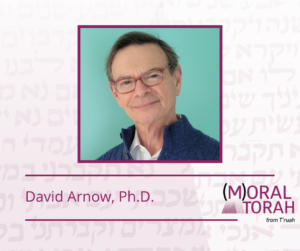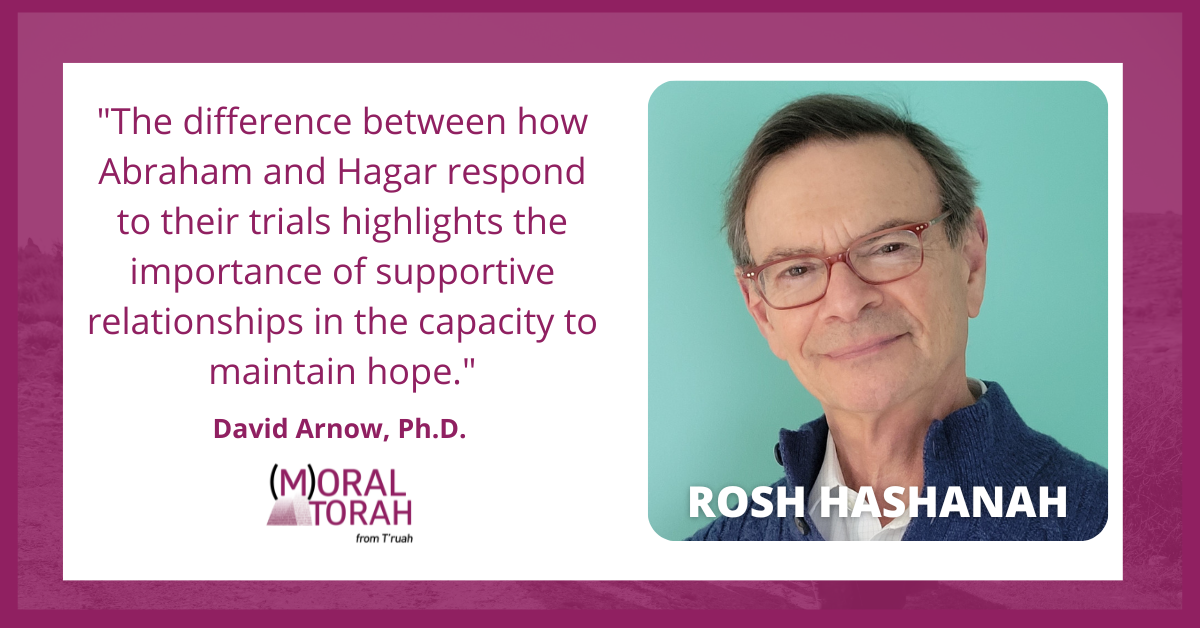A D’var Torah for Rosh Hashanah by David Arnow, Ph.D.
From climate change and the erosion of democratic norms to the resurgence of antisemitism and the fight for human rights, one thing is clear: If despair triumphs over hope, we’ll never overcome the challenges we face. Hope enables us to envision a better future and fuels our commitment to build it.
We can learn a lot about hope and despair if we apply the thinking of French philosopher Gabriel Marcel (1889-1973) to the Akedah (the Binding of Isaac) and the expulsion of Hagar read respectively on the second and first days of Rosh Hashanah. Marcel wrote about hope as an individual’s or society’s response to a trial.
Let’s begin with the Akedah, which according to tradition constitutes the last of Abraham’s 10 trials: “Sometime afterward God put Abraham to the test…” (Genesis 22:1).
Sign up to receive (M)oral Torah in your inbox each week.
Hope thrives when the future is open to different possibilities. “Take your son… to the land of Moriah, and offer him there as a burnt offering” (Genesis 22:2). The Hebrew (v’ha’a’leihu sham l’olah) can also be read as “raise (or bring) him up there as burnt offering.” Midrash HaGadol (14th or 15th century) imagines Abraham’s quandary: “I don’t know whether this means to bring him as an actual burnt offering or to raise him up to the top of the altar in place of a burnt offering, to the place where the burnt offering is performed.” Uncertainty points to possibility, to an open future, the place where hope resides.
Hope means acting as if you can see the outcome you desire. Abraham says very little throughout the story, but both of his substantive utterances speak to his hope. First he tells his servants that he and Isaac will ascend Mount Moriah to worship and “we will return to you.” As Rashi and many midrashim explain, Abraham’s words were a prophesy — a vision of the future he hoped to see. Then when Isaac asks where the sheep is for the burnt offering, Abraham again expresses his hope: “God will see to the sheep.”
Hope requires that you keep moving through the trial because movement reveals new possibilities. The story is one of constant movement. The first verse after Abraham receives God’s command to offer up Isaac contains six verbs: Abraham rose, saddled, took, cleaved, rose up, and went (Genesis 22:3). Abraham’s movements are patient, measured, and purposeful, as if he’s put his confidence in a process that will lead to the fulfillment of his hopes.
Hope means remaining true to yourself throughout the trial. Abraham responds hineini, “here I am,” three times during the Akedah: at the beginning of the story when God initially calls his name, in the middle when Isaac indicates he wants to ask his father a question, and at the end when the angel of God tells him not to harm Isaac. The consistency of these responses illustrates the constancy of Abraham’s character throughout the ordeal. When reality precludes the outcome you desire, hope focuses on the struggle to retain your integrity, come what may.
Abraham’s hope becomes all the more evident when compared to the expulsion of Hagar, an episode that precedes the Akedah that we read on the first day of Rosh Hashanah. Years after giving birth to Isaac, Sarah orders Abraham (with God’s assent) to send Hagar, her handmaid/slave, and Ishmael, son of Abraham and Hagar, out into the desert with a single container of water.
She wandered about in the wilderness of Beer-sheba. When the water was gone from the skin, she left the child under one of the bushes and went and sat down at a distance, a bowshot away; for she thought, “Let me not look on as the child dies.” And sitting thus afar, she burst into tears. (Genesis 21:14–16)
Find more commentaries on Rosh Hashanah.
Abraham moves purposefully forward. Hagar wanders. Abraham keeps going. Hagar sits down. Abraham remains in relationship with Isaac throughout. Hagar abandons her son. Abraham envisions the resolution he desires. Hagar can only foresee Ishmael’s death. Abraham responds to his trial with hope; Hagar responds to hers with despair.
The difference between how Abraham and Hagar respond to their trials highlights the importance of supportive relationships in the capacity to maintain hope. Marcel notes that without fellowship, hope remains timid. Abraham is a prosperous man who sets out on a journey with his wife, father, and nephew. Hagar the Egyptian, whose name is related to ger, “stranger,” is also far from her native land but completely cut off from family. According to one midrashic tradition (Genesis Rabbah 45:1), Hagar was Pharaoh’s daughter. When Pharaoh realizes that God has a special relationship with Abraham and Sarah (Genesis 12:17), he blithely presents his daughter to Sarah to curry God’s favor. Hagar’s isolation deepens as her treatment by Sarah becomes harshly abusive. The Bible uses the same verb (l’anot) to describe the affliction of Hagar by Sarah (Nachmanides finds Abraham complicit as well) and the subsequent affliction of the Israelites in Egypt.
 The expulsion of Hagar and the Akedah illuminate differences between despair and hope. As we begin a new year — “the season of hope,” as Herman Wouk once called it — the Torah readings set before us a choice: despair versus hope. Judaism wants us to choose hope and to treat others in a manner that will enable them to do the same.
The expulsion of Hagar and the Akedah illuminate differences between despair and hope. As we begin a new year — “the season of hope,” as Herman Wouk once called it — the Torah readings set before us a choice: despair versus hope. Judaism wants us to choose hope and to treat others in a manner that will enable them to do the same.
David Arnow is a psychologist and scholar of the festival of Passover. He is the author of Creating Lively Passover Seders, coeditor of My People’s Passover Haggadah, co-author of Leadership in the Bible: A Practical Guide for Today. His most recent book is Choosing Hope: The Heritage of Judaism published by the Jewish Publication Society.

